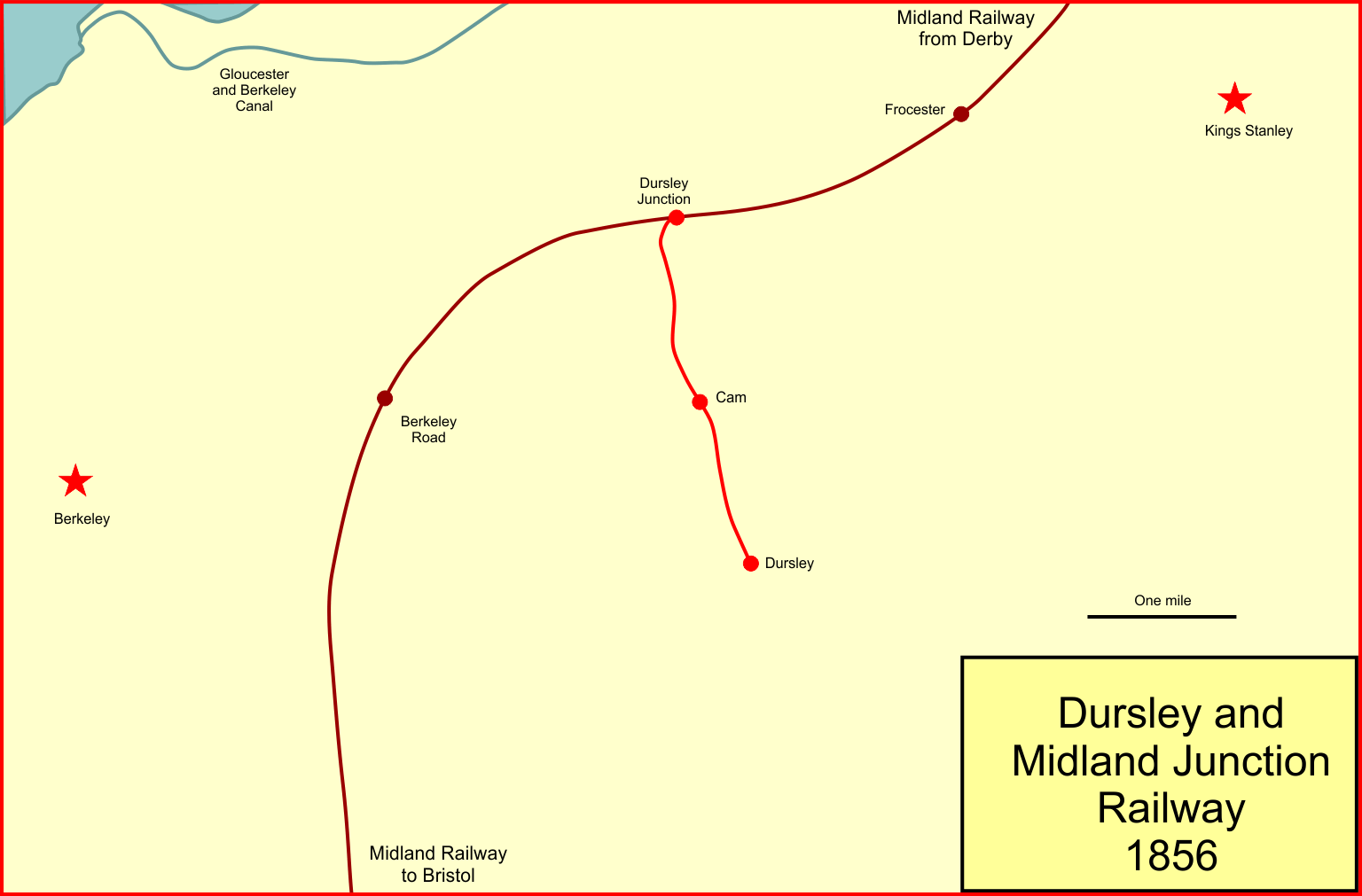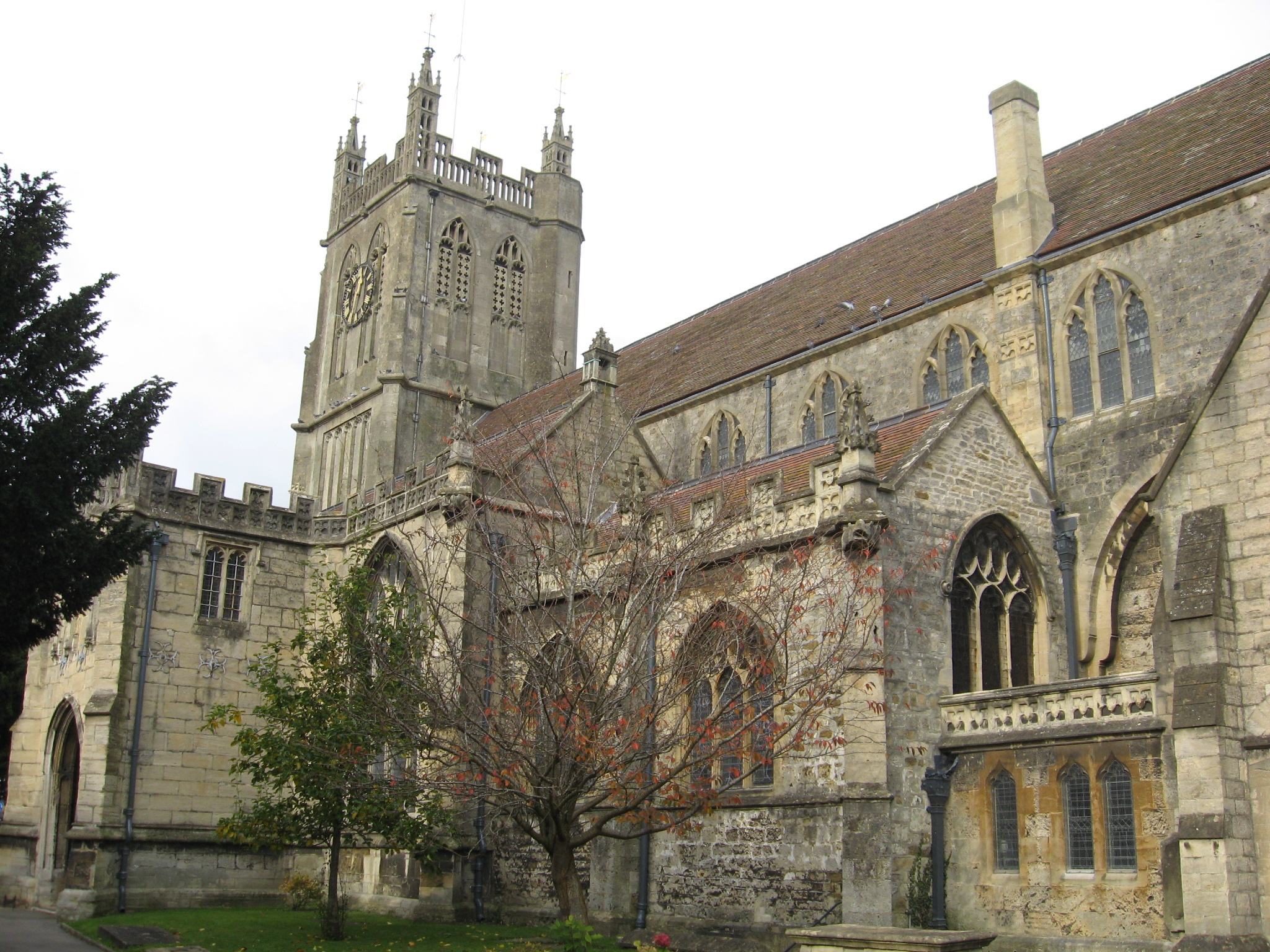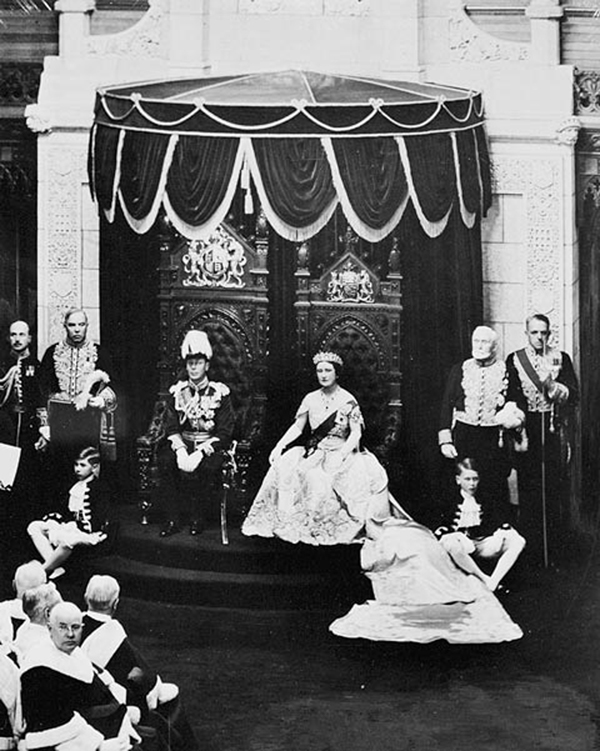|
Dursley And Midland Junction Railway
The Dursley and Midland Junction Railway was a company formed to build a railway branch line to connect the town of Dursley in Gloucestershire, England, to the nearby main line between Bristol and Gloucester, at Coaley. The line was opened in 1856, but was immediately loss-making, and the company soon had to sell its line to the Midland Railway. The line continued in use as a minor rural branch line, and industry located along it sustained it for many years. However, the passenger service was discontinued in 1962 and the line closed completely in 1970. Proposals and opening At the end of the 18th century the Stroudwater Navigation and the Thames and Severn Canal had been opened and provided efficient and cheap transport to the towns it served. The general area was engaged in woollen cloth manufacture, and there were also carpet mills, and the canals gave the nearby town of Stroud a considerable competitive advantage; accordingly, Dursley was declining, not being connected to a ... [...More Info...] [...Related Items...] OR: [Wikipedia] [Google] [Baidu] |
Dursley
Dursley is a market town and Civil parishes in England, civil parish in the Stroud District of Gloucestershire, England. It lies between the cities of Bristol and Gloucester. It is under the northeast flank of Stinchcombe#Stinchcombe Hill, Stinchcombe Hill, and about southeast of the River Severn. The town is adjacent to the village of Cam, Gloucestershire, Cam. The population of Dursley was 7,463 at the 2021 Census. History Ancient historical sites in the vicinity give evidence of earlier occupation. Uley Bury is an Iron Age hill fort dating from around 300 BC. The area also has neolithic long barrows; one called "Uley Long Barrow, Hetty Pegler's Tump" can be entered. Roman remains exist at Frocester, West Hill near Uley, Woodchester and Calcot Manor. Dursley once had a castle, built by Roger de Berkeley in 1153. [...More Info...] [...Related Items...] OR: [Wikipedia] [Google] [Baidu] |
Dursley Railway Station, Late 1960s
Dursley is a market town and civil parish in the Stroud District of Gloucestershire, England. It lies between the cities of Bristol and Gloucester. It is under the northeast flank of Stinchcombe Hill, and about southeast of the River Severn. The town is adjacent to the village of Cam. The population of Dursley was 7,463 at the 2021 Census. History Ancient historical sites in the vicinity give evidence of earlier occupation. Uley Bury is an Iron Age hill fort dating from around 300 BC. The area also has neolithic long barrows; one called " Hetty Pegler's Tump" can be entered. Roman remains exist at Frocester, West Hill near Uley, Woodchester and Calcot Manor. Dursley once had a castle, built by Roger de Berkeley in 1153.Dursley Location Information [Baidu] |
Railway Lines Opened In 1856
Rail transport (also known as train transport) is a means of transport using wheeled vehicles running in tracks, which usually consist of two parallel steel rails. Rail transport is one of the two primary means of land transport, next to road transport. It is used for about 8% of passenger and freight transport globally, thanks to its energy efficiency and potentially high speed.Rolling stock on rails generally encounters lower frictional resistance than rubber-tyred road vehicles, allowing rail cars to be coupled into longer trains. Power is usually provided by diesel or electric locomotives. While railway transport is capital-intensive and less flexible than road transport, it can carry heavy loads of passengers and cargo with greater energy efficiency and safety. Precursors of railways driven by human or animal power have existed since antiquity, but modern rail transport began with the invention of the steam locomotive in the United Kingdom at the beginning of the 19th ... [...More Info...] [...Related Items...] OR: [Wikipedia] [Google] [Baidu] |
Rail Transport In Gloucestershire
Rail or rails may refer to: Rail transport *Rail transport and related matters *Railway track or railway lines, the running surface of a railway Arts and media Film * ''Rails'' (film), a 1929 Italian film by Mario Camerini * ''Rail'' (1967 film), a film by Geoffrey Jones for British Transport Films * ''Rail'' (2024 film), a Tamil-language film Magazines * ''Rail'' (magazine), a British rail transport periodical * ''Rails'' (magazine), a former New Zealand based rail transport periodical Other arts *The Rails, a British folk-rock band * Rail (theater) or batten, a pipe from which lighting, scenery, or curtains are hung Technology *Rails framework or Ruby on Rails, a web application framework *Rail system (firearms), a mounting system for firearm attachments *Front engine dragster *Runway alignment indicator lights, a configuration of an approach lighting system *Rule Augmented Interconnect Layout, a specification for expressing guidelines for printed circuit boards; companion ... [...More Info...] [...Related Items...] OR: [Wikipedia] [Google] [Baidu] |
Closed Railway Lines In South West England
Closed may refer to: Mathematics * Closure (mathematics), a set, along with operations, for which applying those operations on members always results in a member of the set * Closed set, a set which contains all its limit points * Closed interval, an interval which includes its endpoints * Closed line segment, a line segment which includes its endpoints * Closed manifold, a compact manifold which has no boundary * Closed differential form, a differential form whose exterior derivative is 0 Sport * Closed tournament, a competition open to a limited category of players * Closed (poker), a betting round where no player will have the right to raise Other uses * ''Closed'' (album), a 2010 album by Bomb Factory * Closed GmbH, a German fashion brand * Closed class, in linguistics, a class of words or other entities which rarely changes See also * * Close (other) * Closed loop (other) * Closing (other) * Closure (other) * Open (other) Ope ... [...More Info...] [...Related Items...] OR: [Wikipedia] [Google] [Baidu] |
Cam And Dursley Railway Station
Cam and Dursley railway station is a railway station serving the large village of Cam, Gloucestershire, Cam and the market town of Dursley in Gloucestershire, England. It is located on the main Cross-Country Route, Bristol-Birmingham line, between Yate and Gloucester, at a site close to where Coaley Junction railway station was situated from 1856 to 1965. The new station Following a campaign for the reopening of Coaley Junction, the new station called Cam and Dursley opened on 14 May 1994, about north of the original site, although full opening did not occur until 30 May 1994. The new station is unstaffed, and consists of two platforms, linked by a footbridge, a car park covered by Closed-circuit television, CCTV and a bus stop with shelter. Passenger facilities consist of shelters with seats on both platforms and a ticket machine, with passenger help points installed in late 2010. Passenger services are provided by Great Western Railway (train operating company), Great Wester ... [...More Info...] [...Related Items...] OR: [Wikipedia] [Google] [Baidu] |
R A Lister And Company
R A Lister & Company was founded in Dursley, Gloucestershire, England, in 1867 by Robert Ashton Lister, Sir Robert Ashton Lister (1845–1929), to produce agricultural machinery. In 1986 it was bought and merged. In 2014, after 147 years, residual assembly production moved to Hardwicke, Stroud. History 1867–1906: Foundation and growth The founder of R A Lister and Company was Robert Ashton Lister, who was born in 1845. He led the exhibit of the family's products to the Paris Exhibition of 1867, but on return fell out with his father, and in the same year founded R.A.Lister and Company in the former Howard's Lower Mill, Water Street in Dursley to manufacture agricultural machinery. In 1889 Robert acquired the UK rights to manufacture and sell Denmark, Danish engineer Mikael Pedersen's new cream separator, which through a spinning centrifugal separator allowed the machine to run at a constant speed and hence create a regular consistency of cream. Marketed in the UK and Briti ... [...More Info...] [...Related Items...] OR: [Wikipedia] [Google] [Baidu] |
Railways Act 1921
The Railways Act 1921 ( 11 & 12 Geo. 5. c. 55), also known as the Grouping Act, was an act of Parliament enacted by the British government, and was intended to stem the losses being made by many of the country's 120 railway companies, by "grouping" them into four large companies, dubbed the " Big Four". The system of the "Big Four" lasted until the nationalization of the railways in 1947. During World War I, the British government took control, although not ownership, of British railways. The intention was to reduce inefficient internal competition between railway companies, and retain some of the benefits which the country had derived from a government-controlled railway system during the war. The provisions of the act took effect from the start of 1923. History The British railway system had been built up by more than a hundred railway companies, large and small, and often, particularly locally, in competition with each other. The parallel railways of the East Midlands, and ... [...More Info...] [...Related Items...] OR: [Wikipedia] [Google] [Baidu] |
London, Midland And Scottish Railway
The London, Midland and Scottish Railway (LMSIt has been argued that the initials LMSR should be used to be consistent with London and North Eastern Railway, LNER, Great Western Railway, GWR and Southern Railway (UK), SR. The London, Midland and Scottish Railway's corporate image used LMS, and this is what is generally used in historical circles. The LMS occasionally also used the initials LM&SR. For consistency, this article uses the initials LMS.) was a British railway company. It was formed on 1 January 1923 under the Railways Act 1921, which required the grouping of over 120 separate railways into four. The companies merged into the LMS included the London and North Western Railway, the Midland Railway, the Lancashire and Yorkshire Railway (which had previously merged with the London and North Western Railway on 1 January 1922), several Scottish railway companies (including the Caledonian Railway), and numerous other, smaller ventures. Besides being the world's largest ... [...More Info...] [...Related Items...] OR: [Wikipedia] [Google] [Baidu] |
24 & 25 Vict
4 (four) is a number, numeral (linguistics), numeral and numerical digit, digit. It is the natural number following 3 and preceding 5. It is a square number, the smallest semiprime and composite number, and is tetraphobia, considered unlucky in many East Asian cultures. Evolution of the Hindu-Arabic digit Brahmic numerals represented 1, 2, and 3 with as many lines. 4 was simplified by joining its four lines into a cross that looks like the modern plus sign. The Shunga Empire, Shunga would add a horizontal line on top of the digit, and the Northern Satraps, Kshatrapa and Pallava dynasty, Pallava evolved the digit to a point where the speed of writing was a secondary concern. The Arabs' 4 still had the early concept of the cross, but for the sake of efficiency, was made in one stroke by connecting the "western" end to the "northern" end; the "eastern" end was finished off with a curve. The Europeans dropped the finishing curve and gradually made the digit less cursive, endi ... [...More Info...] [...Related Items...] OR: [Wikipedia] [Google] [Baidu] |
Midland Railway (Additional Powers) Act 1861
The Midland Railway (MR) was a railway company in the United Kingdom from 1844. The Midland was one of the largest railway companies in Britain in the early 20th century, and the largest employer in Derby, where it had its headquarters. It amalgamated with several other railways to create the London, Midland and Scottish Railway at grouping in 1923. The Midland had a large network of lines emanating from Derby, stretching to London St Pancras, Manchester, Carlisle, Birmingham, and Bristol. It expanded as much through acquisitions as by building its own lines. It also operated ships from Heysham in Lancashire to Douglas and Belfast. A large amount of the Midland's infrastructure remains in use and visible, such as the Midland Main Line and the Settle–Carlisle line, and some of its railway hotels still bear the name '' Midland Hotel''. History Origins The Midland Railway originated from 1832 in Leicestershire / Nottinghamshire, with the purpose of serving the needs of local ... [...More Info...] [...Related Items...] OR: [Wikipedia] [Google] [Baidu] |
Royal Assent
Royal assent is the method by which a monarch formally approves an act of the legislature, either directly or through an official acting on the monarch's behalf. In some jurisdictions, royal assent is equivalent to promulgation, while in others that is a separate step. Under a modern constitutional monarchy, royal assent is considered little more than a formality. Even in nations such as the United Kingdom, Norway, the Netherlands, Liechtenstein and Monaco which still, in theory, permit their monarch to withhold assent to laws, the monarch almost never does so, except in a dire political emergency or on advice of government. While the power to veto by withholding royal assent was once exercised often by European monarchs, such an occurrence has been very rare since the eighteenth century. Royal assent is typically associated with elaborate ceremony. In the United Kingdom the Sovereign may appear personally in the House of Lords or may appoint Lords Commissioners, who anno ... [...More Info...] [...Related Items...] OR: [Wikipedia] [Google] [Baidu] |








